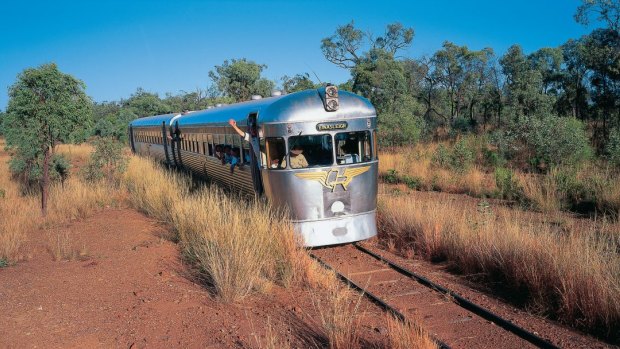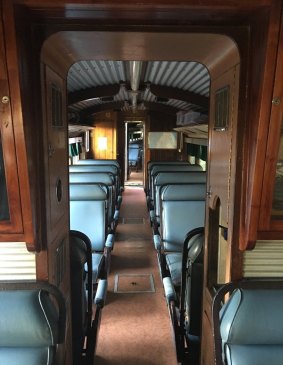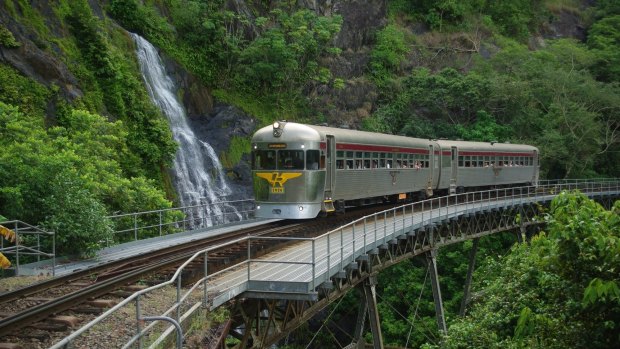This was published 4 years ago
The Savannahlander: An epic and eccentric rail trek through outback Queensland
By Tim Richards

Savannahlander at Turkey Creek Flat.
"We're your train drivers for today, Thursday, Friday and Saturday. So if you don't like us, tough."
It says a lot for the informal vibe of the Savannahlander that this announcement is met with general laughter. It's nearing the end of the train's operating season – it halts over the wet season – so there's only a dozen passengers on board. It's easy to move about in the carriage and make friends, so the journey has a relaxed feel.
Not that the Savannahlander is ever a starchy, formal, white-linen-tablecloth kind of experience. This train is emphatically not the Orient Express, but rather pioneer railway technology which has improbably survived into the 21st century. It now provides a weekly tour into the Gulf Savannah region west of Cairns.

Inside the Savannahlander.
"If it wasn't for tourism, this railway wouldn't operate today. It's a very expensive section of track to maintain," says driver Anthony, one of a duo who will take us to the former mining town of Forsayth and back.
He's not exaggerating. The Tablelands line through the Kuranda Range to Mareeba was a monumental undertaking, and took six years to build from 1887. A further privately built branch line reached Forsayth in 1910, and that's the route covered by the Savannahlander.
Though there are various fare options, the most popular is the Savannah Explorer, a four-day trek including transport, accommodation, breakfasts, dinners and side excursions, and that's the tour I'm taking.

Stoney Creek Falls, on the Kuranda line.
DAY 1: CAIRNS TO ALMADEN
Having boarded at dawn in Cairns, it's about 7.45am when we sight the Barron River for the first time. After passing through the last of 15 tunnels we stop at Barron Falls Station to view the dramatic waterfall that cascades down the rocky mountain face. It's cool and refreshing up here, and I start to think the train's lack of air-conditioning might not be a problem. After all, the windows open and the airflow is keeping the carriage cool – for now.
The interior of the two carriages is appealing in an old-school way, each with an arched corrugated iron roof held together by timber beams, with maroon curtains on the windows and a speckled red linoleum floor. From outside the train is even more striking, the front carriage having a curved stainless steel nose bearing a giant stylised QR symbol.
We pause briefly at beautiful Kuranda Station, festooned with potted plants, which is the terminus of the day-tripping Kuranda Scenic Railway. "From here we're the only scheduled passenger service on the line," says Anthony.
After leaving the rainforest we pass into thick woodland before traversing the farming country of the Atherton Tablelands, passing mango trees as we go. At Mareeba we transition to the noticeably bumpier Chillagoe line, which opened in 1901 to serve mines, then enter the savannah. It's cattle country here, with sparse trees separated by native grass.
The train calls a halt for the day at Almaden, a dry, dusty town with broken-down shacks and the Railway Hotel. It couldn't look more like the set of a Western movie if it tried. Lunch is at the pub, a $10 plate of meat and salad. We may just have passed some of the largest avocado farms in Australia, but there's not a lot of avo to be seen around here. After the Tablelands we've gone back decades in Australia's food history; there'll be lots of old-school meat and two veg from here on.
Accommodation for the night is at nearby Chillagoe, where we're bussed. Though the food is underwhelming on this tour, the accommodation is surprisingly good. I'd been expecting musty old motel rooms, but Chillagoe Eco Lodge is dotted with attractive cabins in quirkily decorated gardens, with an onsite observatory presenting night sky viewings in the peak season.
The afternoon's tour is to the Royal Arch Cave, an impressive collection of underground chambers which we're led through by Eddie, a knowledgeable Indigenous ranger. It's an intriguing mini-adventure, with marked paths leading past striking formations resembling seahorses, bats, horses, and even the profile of Queen Victoria.
DAY 2: ALMADEN TO FORSAYTH
From Almaden the Savannahlander rides along the Etheridge line, which branched toward Forsayth from 1907. This was built even more cheaply than the line from Mareeba, on very light rails.
"It really is spaghetti rail, two pieces of spaghetti held together as a track," says Anthony. I can see what he means. As we progress through the increasingly empty landscape with its bone-dry creek beds and slender windswept trees, there's a distinct rolling motion. Yesterday it was a steady bump up and down, now it's side-to-side as well.
For morning tea our driver picks a random stretch of rail at which to halt, and lays out tables bearing fruitcake and hot beverages in the shade of the train.
While he's setting up, a British fellow passenger and I wander about, admiring the stark landscape. We comment how remarkable it is to be standing on the tracks in front of a train, something you'd never get away with in Europe. But that's one of the pleasures of this tour, the informality of Outback life.
While we're sipping tea, a young dingo suddenly appears from nowhere and trots along the line, casting us a wary glance. We've also seen emus and wallabies today, along with wild horses, so we're doing well on the wildlife front.
In the mid-afternoon, after having stopped for lunch at Mount Surprise, we pull into Einasleigh. While some passengers follow a marked trail to the nearby Einasleigh Gorge, I hit the Einasleigh Hotel, another classic Outback drinking hole with blokes in Akubras parked around the central timber bar (made, I'm told, from the salvaged floorboards of a collapsed dance hall).
It's a brilliant old pub, a good place to recharge with a beer and admire its curious exhibition of miniature houses, which were crafted by an ancestor of the current publican.
It's hotter on the train today, and at one point we have to slow while a herd of Brahman cattle lumber along the rails. After a long ride we're glad to reach Forsayth, and then by four-wheel-drive bus the comfortable cabins of Cobbold Village.
DAY 3: FORSAYTH TO MOUNT SURPRISE
The day starts with a cruise along Cobbold Gorge, aboard low quiet boats powered by electric outboard motors. We progress serenely along the calm waters, flanked by dramatic red-brown rock walls on each side. There are crocodiles here, says our guide, but they don't emerge until the afternoon when it's warmer. We do encounter spiders, in nooks of the rock face within decorative spiral webs. This cruise is a high point of the trip, an extended moment of calm in contrast to the rattle and sway of the train.
We're bused to Einasleigh to rejoin the Savannahlander, which departed Forsayth while we were in the gorge, and dine on a lunch of wraps and beer. While retracing our route to Mount Surprise, driver Wil talks about the clashes between the town's early settler Ezra Firth and the local Indigenous people. The "surprise" in the town's name had long been ascribed to a harmless cultural clash, says Wil, but in truth refers to an armed attack carried out by Firth against the locals.
At Mount Surprise I'm staying at the pleasant Bedrock Village, with self-contained cabins and a pool. The excursion from here is to the spectacular Undara Lava Tubes, huge caves created by lava flows some 200,000 years ago.
DAY 4: MOUNT SURPRISE TO CAIRNS
It's been a busy tour, so it comes as a relief to discover the final day's itinerary is mostly sitting on the train.
As we leave Mount Surprise, Anthony points out Radar Hill, where Australian and US military forces tested out radar during World War II. As displays at Mount Surprise Station point out, this railway line was extraordinarily busy during the war. Its proximity to the Pacific conflict made it invaluable for transporting supplies and troops, including patients evacuated by air from New Guinea.
Lunch is at Almaden, a buffet of cold meat and salads this time, and on the pub's deck I get talking to a pair of motorcyclists who are heading the way we've come. It's raining in the Tablelands, they say, which seems unbelievable here in this desiccated savannah country. It's a reminder there's another world at the end of this tour, of oceans and cities and people (and avocados), that's barely aware of this eccentric silver train rattling weekly through the Outback. It doesn't know what it's missing out on.
FLY
Qantas flies to Cairns, see qantas.com.au
STAY
Novotel Cairns Oasis Resort is a relaxing place to stay, with rooms from $190 a night. See novotelcairnsresort.com.au
Cairns Central YHA is a good budget option near the railway station, with private rooms from $63 a night. See yha.com.au
RIDE
The four-day Savannah Explorer tour aboard the Savannahlander costs $1360 to $1490, depending on chosen accommodation. Other tour and fare options are available. See savannahlander.com.au
Tim Richards travelled courtesy of Cairns Kuranda Steam and associated operators.
See also: On board Australia's new luxury train journey
See also: Luxury train returns to the Melbourne-Sydney route
Sign up for the Traveller Deals newsletter
Get exclusive travel deals delivered straight to your inbox. Sign up now.